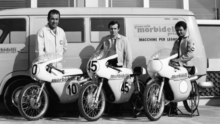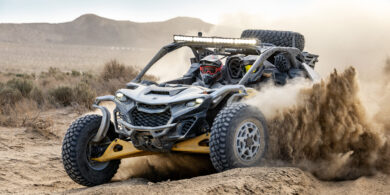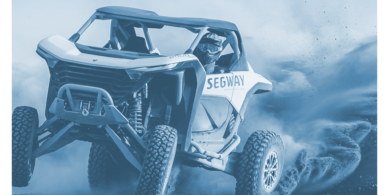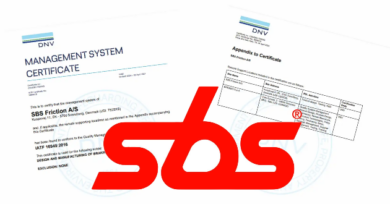Dec. 3, 2007 – The rebuilding of Triumph
By Neil Pascale
Editor
HINCKLEY, England — Just steps off a Triumph manufacturing plant’s third-floor elevator is a panoramic view of its homeland. Locals call it the Midlands, and it encompasses much of what modern England is known for today: long expanses of green fields and tidy rows of brick homes.
Most noticeably, however, is the lack of another skyline competitor to this, the largest of Triumph’s two production facilities in England.
Hinckley, home to the brand that was started more than 100 years ago, is characteristic of the rest of the Midlands in that its motorcycle-manufacturing heyday has seemingly come and gone. The motorcycle brands once prevalent in the Midlands have largely failed, been sold or much like Hinckley’s once-thriving hosiery business, succumbed to lower-cost competition from other parts of the world.
Even Triumph seemed destined for the same fate. But a self-made businessman with an inkling for engineering changed all that nearly a quarter century ago. Homebuilder John Bloor paid 100,000 pounds in December 1983 for the intellectual rights and brand name of Triumph’s motorcycles, and in the years that followed poured many more hundreds of thousands of pounds into the company’s rebirth.
Those efforts took a frightening turn in 2002 when a late-night fire burned the company’s only production facility. But from those ashes came a different Triumph; a company that made a conscious effort to look inwards perhaps more so than it ever had before.
“We just stuck with it,” said Bloor, seated in a third-floor room that showcases just how far his solely owned company has come since that devastating blaze.
The result, on a global scale, is relatively small for an industry that boasts manufacturers that produce hundreds of thousands, if not millions, of vehicles per year. But the recent triumphs of Triumph mean the company has a real shot at doubling its global market share in the next few years and in doing so, continuing something so unique to the Midlands’ motorcycle manufacturing world: a success story in the 21st century.
Not far from the two Triumph facilities in Hinckley is a pub with roots dating back to the 13th Century. Its partially thatched roof is a testament to that, as are the historic treasures gracing its interior walls, not to mention the low ceilings. Indeed, a sign that reads “duck or grouse” says less about the menu than the placement of its wooden beams.
On March 15, 2002, Triumph officials could not duck, nor would they grouse, from the terribly costly fire. The blaze engulfed the company’s lone plant, burning down its offices and assembly line. Thanks to the efforts of more than 100 firefighters, the blaze was halted mere feet away from the company’s paint shop and machinery area.
Within the crowd of people on-hand that night were Bloor and two employees who in time would rise through the company’s ranks to be the general manager of a major division and the CEO of the company’s North American subsidiary. The latter, Mark Kennedy, remembers walking through the remains of the warehouse, witnessing first-hand the bent steel and motorcycles that had “disintegrated.”
Paul Checkley, Triumph’s parts and accessories general manager, recalls Bloor stopping him on that fateful Friday night and asking him to help organize a meeting for the following morning.
At 8 a.m. the next day, “John sat down with us and said, ‘Well what are we going to do to get it back together again?’ And we went from there. There was never any other discussion” regarding Triumph’s fate.
In fact, it turned out to be the first of many discussions about Triumph’s future. Discussions that would set the tone for what Triumph would become not just once production began again in six months, but years later.
“Because we didn’t have bikes to build anymore, we actually took six months to figure out what we were going to do with the business,” Kennedy said. “I’m sure it was going to happen anyway; it just came forward because this was the time to look at it.”
Helping Triumph officials ask those questions, and ultimately answer them, were management consultants the company hired from funds it received from the fire insurance settlement.
“A lot of the things they (the management consultants) discussed at the time were quite alien to us,” Checkley said.
Among those alien topics: What does Triumph mean? What does it mean to its dealers and its ultimate customers? Should the company use the British flag’s Union Jack as part of its logo? Or could that be a negative, and should it be removed from the logo?
In the quest to solidify its corporate identity, Triumph funded focus groups in 2003 of customers, dealers and its staff in three countries: the United States, United Kingdom and Germany.
Among the conclusions from that soul-searching time: a resolve to stick to its twin-cylinder and three-cylinder engine formats and to no longer be satisfied with being just another brand in a dealer’s arsenal.
Both decisions had tremendous impacts.
First, Triumph began demanding to be a dealer’s No. 1 or No. 2 brand in terms of focus and showroom presence, a decision that led to a sizeable reduction in its North American dealer network and perhaps ultimately a rise in its sales per dealer.
Secondly, and perhaps more significantly, it shelved a motorcycle model — a sport bike that was ready to be launched — at the cost of millions of pounds.
“All the design was finished,” Checkley said of the sport bike. “All the testing was done. We were just going into production stage.”
The sport bike never touched the street because the fire halted production, and the discussion afterward led company officials to believe the bike’s four-cylinder engine did not fit into the newly identified and redefined corporate identity.
“We’ve learned that from a business standpoint it makes sense to have a broad range” of product, said Tue Mantoni, Triumph’s commercial director, “but we need to make sure that we’re being distinctive in the offering of the individual products. So a Triumph needs to look like a Triumph, sound like a Triumph and run like a Triumph.
“You will not see a four-cylinder from Triumph. You will not see a V-twin (engine) from Triumph. You will see the twin or the triple because those are the engines that we believe deliver the Triumph experience that we stand for.”
South of Hinckley, the A5, a road filled with England’s characteristic roundabouts, passes by the Hinckley Island Hotel, the site of the Triumph Bar. There, the traditional pub décor of English countryside paintings and small wooden tables with smaller wooden benches are replaced with all things Triumph. A variety of painted gas tanks line a wall, including a black Thruxton tank with a distinctive checkered pinstripe. A wire-rimmed wheel with footpegs circling it, looking much like a mariner’s wheel, adorns the opposite wall. Behind the bar is a shiny red Daytona 675, which is perched on a wooden cabinet and bordered by refrigerated cases of Stella Artois and Staropramen beer bottles.
The bar is a representation of the company’s efforts to diversify its product offering, which includes three major categories: cruiser, sport bike and classic.
“We believe the broad range, from a business standpoint, makes a lot of sense for us,” Mantoni said.
Especially in a global sense. The company’s classic bikes, like its iconic Bonneville, have done well in European markets as well as in Japan, which has become infatuated with the leather-and-jeans look forever linked to that model. In other European markets, Triumph’s Speed Triple has garnered a huge chunk of business and remains the company’s biggest seller worldwide. In the United States, all three segments represent surprisingly equal portions of Triumph’s sales. In a country dominated by the heavyweight cruiser segment, Triumph has achieved a strong amount of sales from its heritage lineup of Scramblers, Thruxtons and Bonnevilles.
“We’re doing a very nice job of getting younger people on those motorcycles,” Kennedy said. “It’s not the Baby Boomers; it’s actually the younger people. Retro is cool again.”
The result: Triumph is doing twice as better as the industry for its U.S. sales. While the U.S. on-road market as a whole is down nearly 5 percent through September, Triumph’s new unit sales are up 4 percent. And that follows a stellar year in which Triumph increased its U.S. sales 25 percent.
“It’s quite an interesting time because we’ve grown quite a lot since the fire in 2002,” Mantoni said. “I think the business, in round figures, is twice as big today as it was three or four years ago. But I still believe we’re only scratching the surface as far as where the brand can go.”
So what is the right path for the brand? Right now, company officials believe Triumph holds 2.8 percent of the global market share for motorcycle sales of 500cc and higher. In two or three years, Triumph officials expect their market share to double. In raw numbers that means Triumph’s global new unit sales, which were about 40,000 last year and could reach 50,000 this year, could climb to 70,000 by 2010.
“We still have a relatively small share of the global market,” Mantoni said, “which to me is a good sign because it means (the expected growth) is probably realistic.”
To say everything in Hinckley is smaller than its counterpart in the United States would be exaggerating, but that certainly appears to be the case on a busy weekday morning when condensed-sized vans and mini sport cars line up bumper to bumper on the A5. Even the pumpkins in the Hinckley town center on this Halloween eve appear to be more cantaloupe-sized than the basketball-sized versions common in the United States. For Triumph, this disparity between the United Kingdom and the United States doesn’t extend to its sales per dealer. In fact, the average U.K. sales per dealer often dwarfs their U.S. counterparts. However, this situation is changing.
On average, U.S. dealers this year are selling about 60 bikes per year, a 36 percent increase from two years ago and a 67 percent increase from three years ago. In comparison, it’s not uncommon for British dealers to average 160 new units per year.
“The North American market will become more and more important for us,” Mantoni said, noting the company’s recent new model, the Rocket III Touring, was built by a U.S. motorcycle designer with the U.S. consumer in mind.
To continue its momentum in North America — Triumph is hoping to grow its sales from about 12,000 bikes to 20,000 in three years — the company will focus on increasing its average sales per dealer as well as expand its dealer network.
“We have to expand the range on the dealer side,” Kennedy said. “But what we’re not going to do is put dealers on to get that growth. We’re going to put dealers on to cope with that growth.
“We’re not putting dealers next door to each other so all they do is just split the sales. We’re actually putting them in unique open points.”
Triumph currently has about 185 dealers in North America, with about 170 of those in the United States. The company is seeking to reach 250 in North America in three years, a number it was at near the time of the 2002 fire. Since that time, Triumph’s North American network has declined in number as the company has shed dealerships that did not give the brand the focus or priority that Triumph was seeking.
“They might still have three or four brands,” Kennedy said of potential North American dealers, “but we still want to be in terms of their focus No.1 or No. 2.
“We won’t reduce the sales per dealer (in a specific area) just to increase more dealers. If it isn’t there, we’re obviously not ready for it.”
But that isn’t the conclusion Triumph reached six months ago. At that time, company officials added an extra step in their review of the 10-year model plan that Triumph updates on a quarterly basis. At that time, Mantoni asked subsidiary managers to look at where they believe the company’s business could go, being mindful of the state of their individual markets.
The conclusion: Triumph is expecting to see sales growth in its key markets of Italy, Germany, France and North America. The latter could be especially noteworthy in a category company officials call the “true measure” of success — sales per dealer.
For North America, Kennedy believes sales per dealer, which are hovering around 60 now, could reach an average of 85 by 2010.
“It could be better, honestly,” he said, noting the company has some U.S. dealerships that already are eclipsing 100 Triumph sales per year.
Inside the lobby of the smaller of the two Triumph facilities in Hinckley are four framed black and white photographs. Each shows a Hollywood megastar, including Steve McQueen and Richard Gere, either on or beside a Triumph motorcycle in a major motion picture. Fittingly, the photos are easily identifiable because of their size, but small enough and discreet enough in their positioning to not be the highlight of the lobby.
After all, a company that is expecting great things in the future should not get carried away with the past. For a company that’s brand name and identity is so tied to the past, it’s especially fitting. “We hardly ever look back,” one Triumph official said in discussing the time after the fire, a time of inward focus and decisions that have led to three straight profitable years and the company’s present anticipation of growth.
Triumph officials are hoping the near-term growth will push them over the company’s record for sales in a year, a mark that dates back to the post-World War II era. If that happens, Mantoni said Triumph is planning to invite its entire dealer network next year to England to celebrate the occasion.
An occasion that is especially noteworthy to not only the English motorcycle industry, but to those in the Midlands who have watched other motorcycle manufacturers come and go.
“We had a bloody nose for a few years,” said Bloor, deemed to be “the Triumph savior” among many British motorcycle Web sites, “but if you never have a go at anything, you never achieve anything.”








